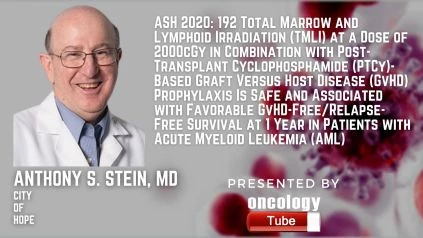Anthony S. Stein, MD of the City of Hope speaks about the ASH 2020 abstract – 192 Total Marrow and Lymphoid Irradiation (TMLI) at a Dose of 2000cGy in Combination with Post-Transplant Cyclophosphamide (PTCy)-Based Graft Versus Host Disease (GvHD) Prophylaxis Is Safe and Associated with Favorable GvHD-Free/Relapse-Free Survival at 1 Year in Patients with Acute Myeloid Leukemia (AML).
Context:
The method that provides the highest curative rate for acute myelogenous leukemia (AML) with moderate or high-risk cytogenetics is Allogeneic hematopoietic cell transplantation (alloHCT). Despite advances in prophylaxis and treatment, graft versus host disease (GvHD) has remained the key cause of post-transplantation mortality and morbidity, adding major economic burdens and affecting the quality of life. Without raising the risk of relapse, it would be beneficial to lower the incidence of GvHD among patients in complete remission (CR). In this study, a novel conditioning regimen of total marrow and lymphoid irradiation (TMLI) at 2000 cGy together with post-transplant cyclophosphamide (PTCy) has been established to 1) decrease the possibly increased risk of PTCy relapse by using increased TMLI radiation doses, as increased radiation doses may decrease the rate of post-transplant relapse (Blood, vol 76, pp). In patients with AML in remission, the main objective of this pilot study of TMLI and PTCy (clinicaltrials.gov: NCT03467386) was to boost GvHD-free/relapse-free survival (GRFS), estimated to be 45% of total body irradiation (TBI) and tacrolimus/sirolimus prophylaxis (BBMT, vol 26(2), pp. 292-299, 2020).
Methods and Patients:
Between March 2018 and December 2019, 18 patients were enrolled and treated (see Table) in total. Age 18 to 60, first or second CR, minimal residual disease negative by multi-color flow cytometry, and normal organ function were the main criteria. TMLI was administered on days -4 to 0 without chemotherapy being applied. The radiation dose for all patients (n=18) was 2000 cGy, administered twice daily in the 200 cGy fraction. The dose of radiation administered to the liver and the brain was held at 1200 cGy. The remaining organs have been declared non-targeted. On day 0.0, all patients were given peripheral blood stem cells. On days +3 and +4, 50 mg/kg of cyclophosphamide was administered per day for GVHD prevention. Tacrolimus, 1 mg continuous infusion, modified to maintain levels of 5 to 10 ng/mL, was administered from day +5 to day +90 and 5 μg/kg G-CSF was administered daily at day +5 until neutrophil counts were restored.
Toxicity, GRFS at 1 year, engraftment, overall survival (OS), and non-relapse mortality were endpoints (NRM). According to the Bearman and CTCAE 4.03 scales, toxicities were described, the latter for hematologic toxicity. To ensure that there were no unintended toxicities, a patient safety lead-in section (n=6) was performed, allowing for a dose de-escalation to 1800 cGy. Acute GvHD, chronic GvHD requiring systemic care, relapse, or death from any cause) was identified as GRFS grade 3-4, whichever occurred first.
Outcomes:
For all patients, Bearman toxicity data is available. The grade 2 toxicities among these patients were bladder toxicity and stomatitis. No toxicity or toxicity-related deaths in grades 3-4 were observed. In 2 of the patients (100-day Grade II-IV aGVHD: 11.1 percent, 95 percent CI: 1.7-30.4), acute GVHD (aGVHD) developed; of those only 1 patient developed Grades III-IVI-IVI (100-day Grade III-IV aGVHD: 5.6 percent, 95 percent CI: 0.3-23.1). The occurrence of moderate chronic GVHDD in five patients (1-year cGVHD rate: 28.6 percent, 95 percent CI: 7.5 percent -54.7 percent ). The 1-year GRFS rate was 59.3% (95% CI: 288-803) (Figure).
For surviving patients, the median follow-up was 11.3 months (range 4.7 to 25.4) (n=17). Engrafting all patients. The recovery time for neutrophils and platelets was 14 days (range 13-32 days) and 20 days (range 11-49 days). One-year estimates of OS and relapse-free survival were 100% and 80.8% (95% CI: 50.5-93.6), respectively (Figure). At 1 year, disease relapse was 19.2 percent (95 percent CI: 4.1-42.6). At 100 days and 1 year, the NRM figures were both 0 percent. In 3 patients, the relapsed disease after transplantation occurred in (16.7 percent ). Since relapsing, one patient died.
Findings:
1) Along with PTCy and tacrolimus, this chemotherapy-free conditioning regimen is safe and practical, with no NRM. 2) Engraftment is done in all patients. 3) Participants with a follow-up duration of nearly one year have stopped immunosuppressive treatment, reducing the financial burden, and improving the quality of life. An increased GRFS rate is indicated by the preliminary results. To corroborate these results, a larger phase 2 trial is in preparation.

